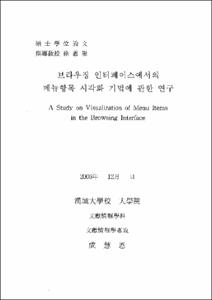브라우징 인터페이스에서의 메뉴항목 시각화 기법에 관한 연구
- Abstract
- 인터넷과 정보기술의 발달로 인하여 디지털 정보의 유형이 다양해지고 유통되는 정보의 양이 증가함에 따라 웹 기반의 정보검색 환경은 변화되고 있다. 전통적인 정보검색 환경에서는 텍스트 형태의 자료에 대한 검색의 효율성을 지향하였지만 최근의 정보검색 환경은 다양한 매체로 표현된 정보를 다양한 방식으로 탐색할 수 있는 이용자 편의성을 지향하고 있다. 따라서 정보시스템은 질의어 기반의 불리언 탐색 인터페이스뿐 아니라 잠재적인 정보요구를 구체화시키면서 원하는 정보를 찾을 수 있는 브라우징 인터페이스를 제공하고 있다. 더욱이 여러 정보시스템은 브라우징 탐색을 보다 효율적으로 수행할 수 있도록 하는 다양한 시각화 기법을 활용하고 있다.
본 연구는 긴 메뉴항목 리스트를 효율적으로 브라우징 시키기 위하여 실제 시스템에서 많이 사용되고 있는 메뉴항목 시각화 기법을 선정하여 각각의 기법에 대한 이용자의 선호도를 비교·분석하였다. 이를 위하여 먼저 다섯 가지 방식의 시각화 브라우저, 즉 트리구조방식, 목차방식, 롤-오버방식, 클릭방식, 어안렌즈방식의 브라우저를 구현하였고, 이들을 정보검색에 대한 체계적 경험과 지식을 갖춘 전문가 그룹과 그렇지 않은 초보자 그룹이 명확성, 체계성, 접근성, 간결성 면에서 평가하였다. 그리고 수행과제별 선호도, 시각화 브라우저 방식별 선호도, 평가자 그룹별 선호도에 따라 각각의 브라우저를 비교하였다.
연구수행 결과 다음과 같은 사항을 발견하였다. 첫째, 이용자는 브라우징 할 때에 주제별로 분류하여 계층적으로 디스플레이 되는 계층구조 표현기법보다 자모순으로 정렬하여 연속적으로 디스플레이 되는 선형구조 표현기법을 선호하는 것으로 나타났다. 둘째, 특정 메뉴항목을 찾기 위해 계층적 메뉴를 이용할 경우 전문가는 목차방식 메뉴를, 초보자는 트리구조방식 메뉴를 선호하는 것으로 나타났다. 셋째, 선형적 메뉴를 이용하여 브라우징 할 때에 이용자는 롤-오버방식을 가장 선호한 반면 어안렌즈방식 메뉴를 가장 낮게 평가하였다. 넷째, 전문가 그룹과 초보자 그룹 간의 차이는 체계성 분석에서 상이하게 나타났으며 전문가 그룹은 체계성 있는 계층적 구조의 메뉴를 선호하지만 초보자 그룹은 체계적인 특징을 가진 계층적 구조를 어려워하는 헌상을 보였다.
본 연구는 연구결과를 토대로 하여 긴 메뉴항목 리스트를 시각화할 때 고려해야할 사항을 다음과 같이 제안한다. 첫째, 선형적 브라우징의 간편성으로 인하여 대다수의 이용자가 선형적 표현기법을 선호하므로 브라우징 해야 하는 항목의 양이 적을 경우 계층구조 표현기법보다 선형적 표현기법을 사용하도록 한다. 하지만 항목의 수가 많아 메뉴항목 리스트의 길이가 긴 경우에는 선형적 구조와 계층적 구조를 함께 사용해야 할 것이다. 둘째, 이용자는 브라우징 인터페이스에서의 기능보다 디스플레이 디자인과 친숙도를 중요시하므로 정보의 숨김 및 줌과 팬 기능을 적절하게 사용하여 이용자의 조작에 의한 정보의 항해가 이루어지도록 해야 할 것이다. 특히 긴 메뉴항목 리스트에 왜곡기법을 사용할 경우 선형적 왜곡기법을 피해야 할 것이다. 셋째, 메뉴항목의 의미를 정확히 표현하지 못할 경우 이용자는 잘못된 선택을 할 수 있다. 따라서 메뉴항목에 마우스 포인터를 올려놓았을 때에 간략정보가 제공되어야 한다. 넷째, 계층적 구조로 구현된 메뉴항목 브라우저인 경우 순차적 항해만을 제공하기보다는 이전 메뉴로 돌아가지 않고도 새로운 항목을 선택할 수 있는 복합메뉴 형태로 구현해야할 것이다.
|The recent development of information technology associated with the Internet has diversified the types of digital information along with increasing the quantity of information on the web. It also has considerably changed the nature of information retrieval on the web. Whereas the traditional information retrieval environment aimed at an efficient search of text form data, more recent environment of information retrieval is geared to user convenience, in the process of locating information stored by diverse media.
Accordingly, the current information system allows users to persue not only boolean searches based on specific queries but also browsing navigation. This facilitates locating relevant information by further specifying latent information needs. Recently, the information system also uses various visualization techniques in order to conduct browsing navigation efficiently.
The purpose of this study is to find the visualization techniques users prefer. The study experimentally embodies five visualization techniques: namely tree-structure method; table-of-contents method; roll-over method; click method; and fisheye method. And these five techniques are evaluated by two groups(the experts and the novices) in terms of clearness, systemicity, accessibility, and compactness. The results are analyzed by user preference based on the following: 1) task conducted; 2) visualization browsers used; 3) users groups participated.
The study reveals major findings as follows. First, users prefer, in general, a linear structure technique rather than hierarchical structure technique. The former displays information in alphabetical order while the later displays information in a hierarchical manner based on subject classification. Second, when users use the hierarchical structure menus for finding a specific item, experts find a table-of-contents menu more convenience while novices prefer a tree-structure menu. Third, when users use linear structure menus for browsing, they find a roll-over method most convenient, while they least prefer a fisheye method. Finally, differences between the expert group and the novice group are distinct in terms of systemicity.
Based on the above results, this study suggests the followings for the visualization of a long menu item list. First, the linear structure method will be more appropriate than a hierarchical structure method particularly when the number of items for browsing is limited. Most users find the linear structure method more convenient in such a circumstance. Yet, if the number of items increases, thus generating a lengthy list, both linear and hierarchical structure will be useful. Second, user-oriented navigation tools are recommended by using the functions of hiding information, zoom and pan. This is because users emphasize the design and comprehension of display features rather than the function of browsing interface. Third, when a user points on a menu with a mouse pointer, simple information which helps users understand the meaning of a menu. Finally, menu item browser embodied by hierarchical structure needs to embody a complex menu formation that returns to a new item without going back to a previous menu. This will be more effective than providing a chronological navigation.
- Issued Date
- 2007
- Awarded Date
- 2007-08
- Type
- Thesis
- Files in This Item:
-
-
Download
 000000557041.pdf
기타 데이터 / 3.25 MB / Adobe PDF
000000557041.pdf
기타 데이터 / 3.25 MB / Adobe PDF
-
Items in Repository are protected by copyright, with all rights reserved, unless otherwise indicated.